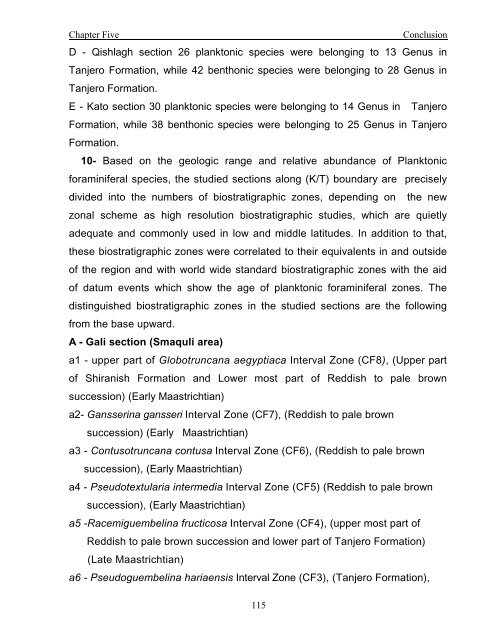biostratigraphy and paleoecology of cretaceous/tertiary boundary in ...
biostratigraphy and paleoecology of cretaceous/tertiary boundary in ...
biostratigraphy and paleoecology of cretaceous/tertiary boundary in ...
Create successful ePaper yourself
Turn your PDF publications into a flip-book with our unique Google optimized e-Paper software.
Chapter Five<br />
Conclusion<br />
D - Qishlagh section 26 planktonic species were belong<strong>in</strong>g to 13 Genus <strong>in</strong><br />
Tanjero Formation, while 42 benthonic species were belong<strong>in</strong>g to 28 Genus <strong>in</strong><br />
Tanjero Formation.<br />
E - Kato section 30 planktonic species were belong<strong>in</strong>g to 14 Genus <strong>in</strong> Tanjero<br />
Formation, while 38 benthonic species were belong<strong>in</strong>g to 25 Genus <strong>in</strong> Tanjero<br />
Formation.<br />
10- Based on the geologic range <strong>and</strong> relative abundance <strong>of</strong> Planktonic<br />
foram<strong>in</strong>iferal species, the studied sections along (K/T) <strong>boundary</strong> are precisely<br />
divided <strong>in</strong>to the numbers <strong>of</strong> biostratigraphic zones, depend<strong>in</strong>g on the new<br />
zonal scheme as high resolution biostratigraphic studies, which are quietly<br />
adequate <strong>and</strong> commonly used <strong>in</strong> low <strong>and</strong> middle latitudes. In addition to that,<br />
these biostratigraphic zones were correlated to their equivalents <strong>in</strong> <strong>and</strong> outside<br />
<strong>of</strong> the region <strong>and</strong> with world wide st<strong>and</strong>ard biostratigraphic zones with the aid<br />
<strong>of</strong> datum events which show the age <strong>of</strong> planktonic foram<strong>in</strong>iferal zones. The<br />
dist<strong>in</strong>guished biostratigraphic zones <strong>in</strong> the studied sections are the follow<strong>in</strong>g<br />
from the base upward.<br />
A - Gali section (Smaquli area)<br />
a1 - upper part <strong>of</strong> Globotruncana aegyptiaca Interval Zone (CF8), (Upper part<br />
<strong>of</strong> Shiranish Formation <strong>and</strong> Lower most part <strong>of</strong> Reddish to pale brown<br />
succession) (Early Maastrichtian)<br />
a2- Gansser<strong>in</strong>a gansseri Interval Zone (CF7), (Reddish to pale brown<br />
succession) (Early Maastrichtian)<br />
a3 - Contusotruncana contusa Interval Zone (CF6), (Reddish to pale brown<br />
succession), (Early Maastrichtian)<br />
a4 - Pseudotextularia <strong>in</strong>termedia Interval Zone (CF5) (Reddish to pale brown<br />
succession), (Early Maastrichtian)<br />
a5 -Racemiguembel<strong>in</strong>a fructicosa Interval Zone (CF4), (upper most part <strong>of</strong><br />
Reddish to pale brown succession <strong>and</strong> lower part <strong>of</strong> Tanjero Formation)<br />
(Late Maastrichtian)<br />
a6 - Pseudoguembel<strong>in</strong>a hariaensis Interval Zone (CF3), (Tanjero Formation),<br />
115

















